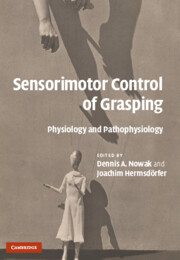Book contents
- Frontmatter
- Contents
- List of contributors
- Preface
- Part I Methodology
- 1 Analysis of grip forces during object manipulation
- 2 Kinematic assessment of grasping
- 3 Digit forces in multi-digit grasps
- 4 Recordings from the motor cortex during skilled grasping
- 5 Recording of electromyogram activity in the monkey during skilled grasping
- 6 Transcranial magnetic stimulation investigations of reaching and grasping movements
- 7 Neuroimaging of grasping
- 8 Functional magnetic resonance imaging studies of the basal ganglia and precision grip
- 9 Models for the control of grasping
- Part II The physiology of grasping
- Part III The pathophysiology of grasping
- Part IV Therapy of impaired grasping
- Index
- Plate section
- References
5 - Recording of electromyogram activity in the monkey during skilled grasping
Published online by Cambridge University Press: 23 December 2009
- Frontmatter
- Contents
- List of contributors
- Preface
- Part I Methodology
- 1 Analysis of grip forces during object manipulation
- 2 Kinematic assessment of grasping
- 3 Digit forces in multi-digit grasps
- 4 Recordings from the motor cortex during skilled grasping
- 5 Recording of electromyogram activity in the monkey during skilled grasping
- 6 Transcranial magnetic stimulation investigations of reaching and grasping movements
- 7 Neuroimaging of grasping
- 8 Functional magnetic resonance imaging studies of the basal ganglia and precision grip
- 9 Models for the control of grasping
- Part II The physiology of grasping
- Part III The pathophysiology of grasping
- Part IV Therapy of impaired grasping
- Index
- Plate section
- References
Summary
Summary
This chapter provides a brief presentation of the available techniques for electromyogram (EMG) recordings in the awake monkey using chronically implanted electrodes. We illustrate how this technique can be used for the analysis of the monkey's motor behavior during dexterous grasp. We also investigate how the grasp specificity of EMG activity can be related to the activity of a population of pyramidal tract neurons (PTNs) recorded from the hand area of the primary motor cortex (M1).
Introduction
The ability to grasp and manipulate objects of various sizes and shapes is essential for a large range of human activities. The debilitating loss of skilled hand movements following stroke, spinal injury and many other pathological disorders results in a marked loss of autonomy for the affected patient. The characteristic structure of the human hand provides this organ with a unique combination of motor and sensory capacities that underpin the control of manual dexterity. The anatomy of the hand includes some 27 different bones, and some 39 different muscles located either in the forearm (extrinsic muscles) or in the hand itself (intrinsic muscles; Tubiana, 1981). Special features of bony structures in the hand contribute directly to dexterity, and are important for rotation of the human thumb during precision grip (Tallis, 2004). The muscular control of the multi-articulate hand presents some demanding biomechanical solutions.
- Type
- Chapter
- Information
- Sensorimotor Control of GraspingPhysiology and Pathophysiology, pp. 61 - 71Publisher: Cambridge University PressPrint publication year: 2009

